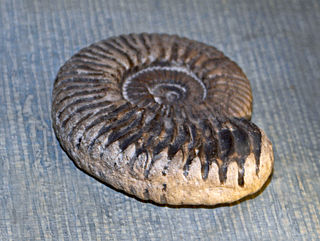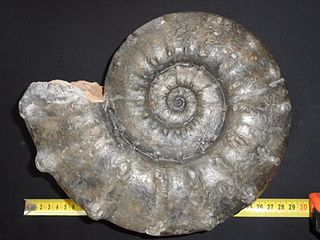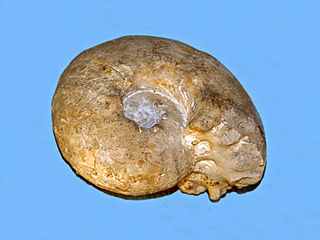Aspidostephanus is an extinct cephalopod genus belonging to the ammonite subclass, included in the perisphinctacean family Olcostephanidae that lived during the earliest Cretaceous and possible latest Jurassic. Fossils of the genus have been found in France, the Balearics, North Africa, and Argentina.
Docidoceras is an extinct ammonite genus from the order Ammonitida that lived during the Middle Jurassic. Docidoceras is included in the family Otoitidae which makes up part of the ammonite superfamily Stephanoceratoidea.
Beudanticeras is an extinct cephalopod genus from the Late Cretaceous period; Albian and Cenomanian, belonging to the ammonoid subclass and included in the family Desmoceratidae.
Uhligella is an extinct cephalopod genus from the Early Cretaceous, belonging to the ammonoid subclass and included in the Desmoceratidae.
Dorsetensia is a narrowly coiled discoidal ammonite from the early Middle Jurassic, lower Bajocian, belonging to the family Sonniniidae of the superfamily Hildoceratoidea. The inner whorls are ribbed or smooth, outer whorl is smooth. The outer rim (venter) is narrow, with a keel running along the middle. The umbilicus, the opening in the middle of the shell exposing inner whorls, is of moderate size with a sharp, sometimes undercut edge.
Oecotraustes is an extinct cephalopod genus included in the ammonid family Oppeliidae and named by Waagen in 1869. The genus lived during the Middle Jurassic.
Oecoptychius is an extinct genus of fossil ammonite cephalopods. The species lived during the Middle Jurassic.

Liparoceras is an extinct fossil ammonite species from the Early Jurassic period of England, and is found in lower Lias deposits. Its name means 'fat head' and this is due to its broad shell. The venter is wide and finely ribbed with no keel and it has two rows of tubercules on each whorl.

Oxynoticeratidae is a family of true ammonites included in the superfamily Psiloceratoidea.

Gymnites is a genus of ammonoid cephalopod from the Middle Triassic belonging to the ceratitid family Gymnitidae. These nektonic carnivores lived during the Triassic period, Anisian age.

Kepplerites is a moderately evolute ammonite from the lower Callovian included in the Stephanoceratoidea.
Hecticoceras is an ammonite genus belonging to the haploceratoid family Oppeliidae, that lived during the Middle and Late Jurassic, from the Callovian. Hecticoceras may be seen as a series of some nine subgenera, beginning with the lower Callovian H. (Hecticoceras) and H. (Hecticoceratoides) and ending with the lower Oxfordian H. (Pseudobrightia) and H. (Eochetoceras). Hecticocerassensu lato and Prohecticoceras from the underlying Bathonian form the oppeliid subfamily, Hecticoceratinae.

The Aspidoceratidae comprise a family of middle and upper Jurassic ammonites that make up part of the superfamily Perisphinctoidea, characterized by evolute shells, commonly stocky, that tend to develop tubercles.

The Peltoceratinae comprise a subfamily in the Aspidoceratidae,.
Megalytoceras is an extinct genus of ammonite from the middle Jurassic, belonging to the suborder Lytoceratina.
Hemilytoceras is a lytoceratin ammonite genus with round inner whorls, outer whorls becoming depressed and in some developing high lamellae (ribs) that bend forward over the venter. The type species H. immanae came from the Tithonian of Europe. The genus is known from the overall Upper Jurassic of central and southern Europe, North Africa, and western India.

Euaspidoceras is an extinct ammonoid cephalopod genus that lived during the Middle Jurassic.

Orthaspidoceras is an extinct ammonoid cephalopod genus belonging to the family Aspidoceratidae. These nektonic carnivores lived during the Jurassic period, Kimmeridgian age.
Ochetoceras is a genus of ammonites, belonging to the Oppeliidae, that lived during the Late Jurassic from the early Oxfordian to the early Tithonian, and type for the subfamily Ochetoceratinae.

Hammatoceras is a genus of ammonites belonging to the family Hammatoceratidae which lived during the Late Toarcian stage of the Early/Lower Jurassic between about 184 and 175 million year ago.









